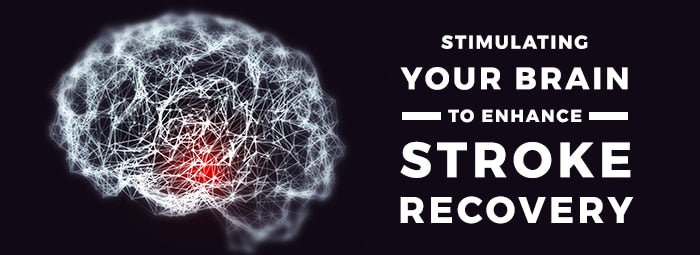Neuroplasticity: Stimulating Your Brain to Enhance Stroke Recovery

While a stroke is effectively an attack of the brain, just as myocardial infarction is an attack of the heart, the brain does fight back against the damage caused by a stroke, and that’s what provides the best opportunity for stroke recovery. Generally, a stroke cuts off the flow of blood to the brain, thereby depriving brain cells of oxygen. If those cells go without oxygen long enough, they die, and brain function decreases. The recovery process relies on the ability of the brain to heal itself through neuroplasticity. Neuroplasticity occurs when brain cells regenerate, re-establish, and rearrange neural connections in response to the damage inflicted by a stroke. In effect, the brain works around the dead cells and attempts to construct other neural pathways to compensate. Physical, occupational, and speech therapy are designed to spark neuroplasticity, encouraging the brain to correct mental and physical deficits. The brain also temporarily increases its natural neuroplasticity in response to traumatic damage, which is why it’s so important to begin the rehabilitation process shortly after a stroke occurs.
How Neuroplasticity Works
The damage inflicted by a stroke is unique to every patient, and so is the recovery process. It is not a one-size-fits-all proposition. The brain uses 100 trillion neural connections or pathways to retrieve and store information. When a stroke occurs, any combination of those 100 trillion connections could be impacted. The brain and the central nervous system can identify environmental, behavioral, and neural damage, but they need assistance and stimulation to change or adapt. That’s where therapists and stroke survivors play a vital role. A variety of exercises and movements can be used to provide cues to the brain. Those cues direct the brain on how to rewire and adapt, creating new neural pathways that can work around any brain damage and alleviate or compensate for physical and mental deficits. Under normal circumstances, the brain adapts continually to new experiences, activities, behaviors, injuries, and trauma. With each new experience, neural connections and cortical maps are remodeled. While the brain may adapt on its own to stroke-related cell death on some level, it must be stimulated with specific cues to adapt and repair effectively. Otherwise, restoration of function will be limited.
Stimulating the Brain
The best way to stimulate the brain and activate the neuroplastic response is through repetitive motion. Heavy repetition of certain movements or activities will retrain the brain and force it to create new neural connections and pathways. The harder a stroke survivor works to retrain the brain, the more likely a positive outcome.. Many of the deficits created by a stroke are treatable through neuroplasticity, including: Hemiplegia. Hemiplegia occurs when a stroke damages the part of the brain that controls movement. Therapists have found that active assistive exercise, such as assisting the movement of affected limbs with unaffected limbs, is the best way to treat the lack of mobility. For example, moving an impacted leg with your unaffected hand, or standing, relying on the strength in one leg to compensate for the lack of strength in the other, can stimulate your brain and encourage it to find ways to increase strength and mobility in the weakened limb. The frequency of structured exercise increases the speed and effectiveness of neuroplasticity. Aphasia. A stroke can seriously impact an individual’s ability to communicate, due to a common symptom called aphasia. This condition can impair speech, writing, and/or the ability to understand language. The impairment is generally treated through speech therapy, which consists of a series of exercises that stimulate the brain to rewire vital neural connections. Again, there is a direct connection between the frequency of speech therapy and the extent to which speech functions are recovered. Sensory Response. Strokes may also impact an individual’s ability to experience sensation in or with their hands, feet, or other parts of the body. Generally, impaired sensory response is treated through sensory re-education. This involves exercises that expose the individual to a variety of textures and temperatures. Each exposure to a new sensory experience stimulates the brain and encourages rewiring. Frequent repetition of the same exercises leads to a faster and more complete recovery.
Repetition Is the Key
While exercise is not always easy when recovering from a stroke, it is essential to a faster and more complete recovery. In many cases, therapists provide materials and tools to assist with continuing an exercise program at home, sometimes with the assistance of a caregiver or family member. Success requires continuity and commitment. A carefully devised and followed exercise plan will ensure that the brain receives the information it needs to recover function after a stroke.
For more information on neuroplasticity and retraining the brain after stroke, view our blog articles: How a Stroke In The Right brain Affects The Body & How to Recover, How Neurorehabilitation Helps With Stroke Recovery, and What is Cortical Plasticity.
Here at Saebo, we are committed to stroke support and recovery for all survivors and their families. Saebo offers a wide range of products that combine cutting-edge technology with evidence-based rehabilitation techniques. Our offerings and network of Saebo-trained therapists can help you or a loved one to obtain all the necessary tools to maximize stroke recovery.
All content provided on this blog is for informational purposes only and is not intended to be a substitute for professional medical advice, diagnosis, or treatment. Always seek the advice of your physician or other qualified health providers with any questions you may have regarding a medical condition. If you think you may have a medical emergency, call your doctor or 911 immediately. Reliance on any information provided by the Saebo website is solely at your own risk.



